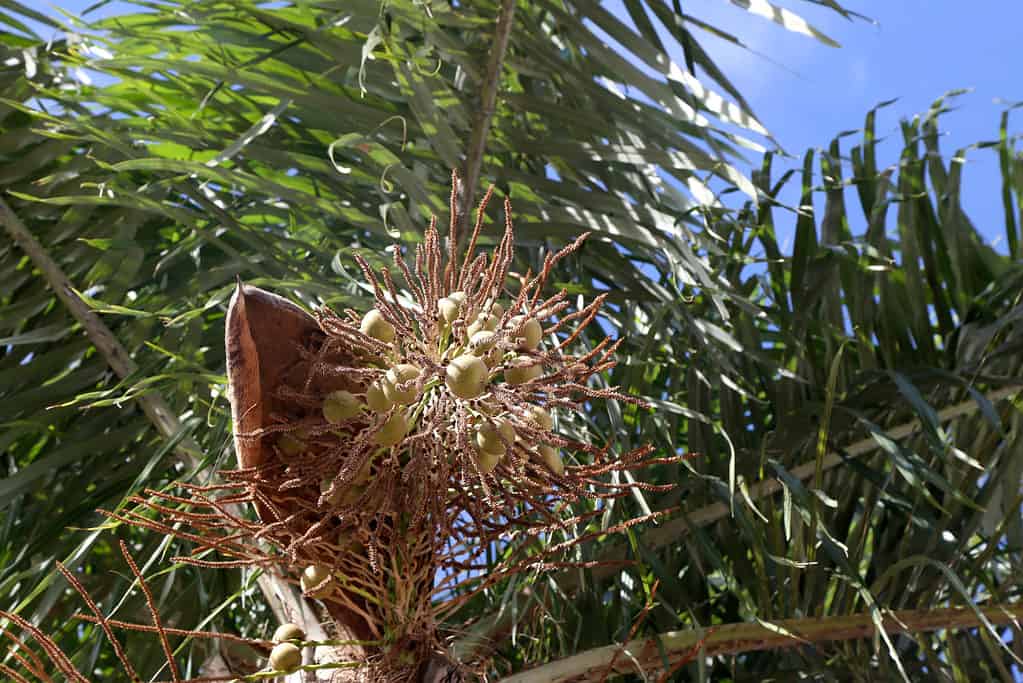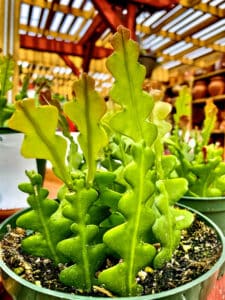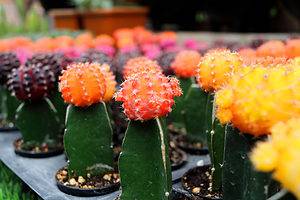The coconut palm tree is by far one of the most popular palm trees in the world, if not the most popular. This lovely palm is used for everything from landscaping to harvesting fruit and coconut oil. Just as well, the coconut palm tree actually makes an excellent houseplant!
In this guide, we’ll look at some key facts and information about the coconut palm tree, as well as how you can grow your very own at home. There’s a lot more to the coconut palm tree than meets the eye!
What is a Coconut Palm Tree?
The coconut palm tree is classified as Cocos nucifera and is a member of the Arecaceae family. It has other names as well, including the Malayan coconut palm and green Malayan palm. It is native to islands in the South Pacific and possibly the Malay Archipelago.
The coconut palm has a single, smooth gray stem that is surrounded by traces of previous leaf growth. Older palms tend to smooth out as they age. The base of the trunk has a swelled appearance and it is often somewhat bent rather than perfectly straight. This palm has a crown of 25 to 30 pinnate, or feather-shaped, leaves on top that can reach lengths of up to 18 feet and widths of seven feet. The 200 leaflets on this species’ enormous leaves, which easily reach 17 feet long, measure about two feet in length. The lifespan of a leaf can range from two to three years. Mature and healthy coconut palms develop new leaves each month while discarding the older ones.
The coconut palm begins to bloom in the spring when it is between four and six years old and has a sweet-smelling golden blossom. Clusters of flowers are supported by thinly branching stalks. The same inflorescence will grow both male and female flowers. They often discharge pollen before female flowers become receptive and are considered protandrous. Once the flowers have gone through their life cycles, coconuts begin to fruit. One of the most well-known and practical fruits in the world is the coconut, and many coconut palms are propagated and cultivated specifically to harvest the tasty and hydrating fruit it produces.
The coconut palm tree is considered a moderate grower. In its original habitat, this palm can easily reach up to 100 feet tall. When grown outside its native habitat or indoors, it usually doesn’t reach more than 30 feet tall. Indoor specimens tend to stay even smaller.
This plant is not very cold-tolerant and will absolutely perish in temperatures below 25 degrees
F. This species can be grown in USDA hardiness zones nine through 11. Despite its lack of cold-hardiness, this is a great species to grow indoors. This species can be grown at any time of year and plant parents can expect a healthy coconut palm to live up to 80 years. Your coconut palm could very well outlive you!

Wild coconut palm trees (pictured) will readily fruit more often than indoor specimens.
©PATRICIA PECEGUINI VIANA/Shutterstock.com
How to Grow a Coconut Palm Tree
The coconut palm is a fantastic plant to keep indoors if you want to enjoy the aesthetics of the tropics without leaving your home. But a word of caution: Unless you live in its natural environment, this plant can be rather difficult to grow on your own. We recommend taking on the coconut palm challenge only if you already have some experience with tropical plants.
The coconut palm, which is indigenous to islands in the Western Pacific, is probably what most people think of when you talk about palm trees. Around the world, these trees do well in hot, humid climates. So, it’s crucial to provide your palm with as much sunlight and warmth as you can while also providing it with enough humidity and moist soil while growing it inside. Regular fertilization is also required for coconut palms. Moreover, as your palm develops, you will need to repot it. In warm weather, it’s also best to put it outside as often as possible so that it can get direct sunshine. This palm tree doesn’t often need much trimming to keep its shape, but you can remove damaged or dead fronds as needed. Palms, in general, are good at dropping dead fronds on their own.
The coconut palm is a thirsty tree, just like many other plants that prefer warmth and humidity. Saturate the soil with warm water once or twice a week to maintain a steady moisture level without making it overly wet. Watch out for waterlogging, which can cause root rot in the container.
The ideal temperature for coconut palms is at least 70 degrees F. They will absolutely die in temperatures under 25 to 30 degrees F and may not even survive if the temperature falls below 64 degrees F. These plants grow best between 85 and 95 degrees F. High humidity is another crucial element to consider before purchasing a potted coconut palm tree. Place a room humidifier near your plant and mist the plant with warm water to keep the atmosphere for your palm as humid as possible, preferably around 70%. To increase the humidity surrounding the plant, you can also keep the pot on a tray with stones and water. Just make sure the container’s bottom doesn’t come in contact with the water.
Coconut palm trees require full sun, or at least six hours of direct sunshine every day, in order to grow. It is crucial that any indoor coconut palm receive plenty of sunlight because even palms found in nature might suffer if they grow in too much shade. Consider altering your plant’s location during the day to chase the sun and make sure it receives the right amount of exposure, depending on where it is located in your house. Consider putting your palm under a grow lamp or another artificial light source throughout autumn and winter to help make up for the lack of sunshine.
Start with a pot that is around three gallons in size, as coconut palms will develop to a substantial size even indoors. You’ll eventually need a pot that can accommodate at least 10 gallons of soil as it develops. Look for something that won’t give under strain, such as a solid plastic or even a well-made wooden barrel. This pot has to be rather substantial to bear the pressure of the coconut palm’s enormous root system.
Coconut palms are not very particular about the soil they are kept in because they are accustomed to growing in a wide range of soil conditions. Therefore, it is usually better to use basic tropical soil that closely resembles the natural habitat of the coconut palm. For potted coconut palms, use a combination of well-draining palm soil and potting soil. It is also recommended to cover the soil with a layer of mulch to aid with moisture retention.
Use a liquid fertilizer all year long to feed your coconut palm tree. It is well-known that coconut palms will often become deficient in a number of nutrients, including phosphate, nitrogen, and manganese. To make up for these losses, look for a fertilizer blend designed particularly for tropical palm trees and adhere to the label’s recommendations for fertilizing frequency and amount to distribute.
Your coconut palm only has to be pruned when there are dead or rotting leaves. Use a sharp knife or a pair of pruning shears to carefully remove them from the tree. Just be sure to sanitize the tool you use beforehand.

Coconut palm trees (pictured) are often cultivated on plantations and farms for their fruit.
©iStock.com/Cheryl Ramalho
How to Transplant a Coconut Palm Tree
Coconut seeds can be planted in three-gallon pots with about 12 inches of potting soil. They don’t require much soil in the early growing seasons since their root balls are initially thin and shallow. Repot the plant into a container with at least 10 gallons of soil when the roots of your coconut palm reach a length of about eight inches. It is ideal to use a thick plastic, wooden, or clay container with many drainage holes so that extra soil moisture can escape through the bottom. It is generally advised to repot your mature coconut palm tree every three years.
How to Propagate Coconut Palm Trees
You can still grow a coconut palm indoors if you can’t get one at a nursery by simply using a coconut! This process can be started at any time of the year, though spring and summer are the best times to do so. Start with a coconut that still has some of its husk on. Put the coconut up to your ear and shake it. If it sounds like it is full of water when you shake it, it can be used to sprout a coconut palm tree.
To aid in speeding up the germination process, soak the coconut for up to three days in a bucket of room-temperature water. After that, bury the coconut in a soil combination that is wet but drains well, leaving the top half of the fruit exposed. Every three days or so, water the pot continuously to keep the soil mildly damp, and move it to a warm, well-lit location. After three to six months, given the correct conditions, a seedling should finally break through the coconut’s shell. Just be patient!
It’s worth noting that while having an endless supply of coconuts would be nice, most indoor coconut plants do not reach the size or maturity to start fruiting. You might just get lucky and eventually get some coconuts, but the chances of that are a bit slim.
Should I Move My Coconut Tree Outside Periodically?
Coconut palms flourish in hot climates. They prefer to be in environments with temperatures of at least 70 degrees F, as mentioned earlier in this guide. When the temperature reaches that point or is hotter, move your coconut palm outside. It doesn’t need to adjust to the warmer temperature.
Protect your coconut palm from colder weather by taking it back inside if possible. As previously stated, the plant can be harmed by temperatures of 65 degrees F or below. As long as you can, let your coconut palm bask in the heat and sunlight. Bring the tree inside as soon as it drops below 65 degrees F or so to prevent harm.
The coconut palm is a fan favorite for a reason. They aren’t insanely difficult to grow, though they are best reserved for more experienced tropical plant collectors. They’re also quite beautiful and can add a tropical flair to any indoor space. What’s not to love about the fun and aesthetically-pleasing coconut palm?
The photo featured at the top of this post is © iStock.com/Thiago Santos
Thank you for reading! Have some feedback for us? Contact the AZ Animals editorial team.







